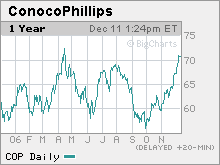 With oil and natural-gas prices easing from their 2006 peaks, buying into a big energy company might seem dangerous. But barring an unforeseen collapse in commodity prices, ConocoPhillips should turn in a solid performance.
With oil and natural-gas prices easing from their 2006 peaks, buying into a big energy company might seem dangerous. But barring an unforeseen collapse in commodity prices, ConocoPhillips should turn in a solid performance.Formed by the 2002 merger of midsized oil firms Conoco and Phillips Petroleum, the Houston energy company is the third-largest U.S. oil operator, behind Exxon Mobil and Chevron. With total U.S. refining capacity of 2.2 million barrels a day, it's the nation's second-largest refiner after Valero. And thanks to its recent $35 billion purchase of Burlington Resources, ConocoPhillips is the country's largest natural-gas producer. This diverse business mix helps smooth earnings.
Unlike many oil industry executives, CEO Jim Mulva isn't sitting on the piles of cash he's built up over the past few years from high energy prices. Instead he's aggressively reshaping the company to spur growth. Mulva will spend $13 billion in 2007 to finance new drilling projects and upgrade investment-starved refineries. He also plans to reduce debt, repurchase stock and increase the dividend; the current yield is 2.1 percent.
What's perhaps most attractive about Conoco is the stock price. Shares sell for just seven times estimated 2007 earnings, a steep discount compared with Exxon Mobil and Chevron, which trade for 11 and nine times earnings, respectively. The gap stems largely from Mulva's willingness to embrace new projects and Conoco's relatively heavy (for an oil giant) debt load. But at 25 percent of capital, the debt is manageable, given Conoco's strong cash flows. And Mulva has proved a good steward of shareholder money. "The company does a great job getting the most out of its assets," says Morningstar analyst Justin Perucki.
